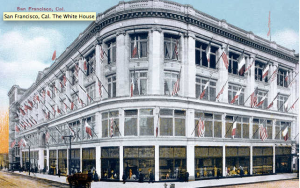This invitation to a fashion show at the Mainbocher couture house in Paris measures a mere 5 1/2 x 7 inches, but the story this simple piece of paper tells is much grander than cursory inspection belies.
Issued to Michel Weill of San Francisco, the carte d’invitation has been stamped GARANTIE D’ACHAT—’guaranteed to purchase’—a stipulation of entrance that was often placed upon department store buyers and representatives from manufacturing houses who came to Paris seeking inspiration for their own lines of ready-to-wear or made-to-measure garments. Paris had set the pace of fashion worldwide since the middle of the nineteenth century (at the very least), and for the American retailer this had developed into a rather complicated game of cat and mouse.
Many retailers and manufacturers purchased the rights to copy Paris originals directly from the couture houses in the form of paper patterns, muslin toiles, or actual couture garments that would be deconstructed stateside for pattern making. Others came with the nefarious intentions of making ‘knock-offs,’ going so far as to plant sketch artists among the audiences of fashion shows; when caught, these interlopers were known to be summarily tossed out! In an effort to restrict this sort of outright piracy, couturiers often dictated the ‘price’ of admission by way of a minimum order. Even so, the culture of copying within the fashion industry during the first half of the twentieth century was rampant. At many of the finest department stores in the US, customers had the option of purchasing either a designer original—a licensed copy of a couture model, made-to-measure in the store’s custom salon—or the store’s own ready-to-wear adaptions (legal or illegal) for a fraction of the cost.

We know from a selection of other cartes d’invitation held here in SPARC, that Mr. Weill was in Paris as a representative of the manufacturer Roditi & Sons as well as the high-end San Francisco department store R. Weill. Also known as ‘The White House,’ the R. Weill department store had been founded by Michel’s uncle Raphael, who began his pursuit of the American dream as a purveyor of dry goods during the boom of the California Gold Rush. Both Weill’s were Parisian by birth, Raphael emigrating in 1855 and his nephew in 1904. Michel eventually took over for his uncle, serving as President of Raphael Weill and Co., which had blossomed into a purveyor of the finest of luxury goods in San Francisco—on this particular trip to Paris, Michel attended fashion shows as a buyer at not only Mainbocher, but also Alix (Madame Grès), Jean Dessès, Dœuillet-Doucet, Jeanne Lanvin, Paquin, Lucile Paray & Jenny, Catherine Parel, Robert Piguet, Jean Patou, and Madeleine de Rauche.
That Michel’s trip occurred in August of 1939 is a fascinating fact all on its own. World War II would erupt just one month later, with the German invasion of Poland, and Paris would find itself occupied and governed by the Nazi regime less than one year later. This was a trying, pivotal period for the French haute couture industry. Many couture houses, such as Chanel and Vionnet simply shut their doors, while others like Jacques Fath and Lucien Lelong struggled along under the draconian systems of rationing implemented by their occupiers—the use of silk, leather and wool was restricted—as valuable resources, including food and gasoline, were funneled towards supporting the German war machine. Some top couturiers fled the country all together. Molyneux returned to England. Schiaparelli held out briefly, only to make her way to America where she volunteered as a nurse’s aid at Bellevue Hospital in New York City.
Anticipating the difficulties lying ahead, Mainbocher, who was American by birth, returned home in October of 1939 (the New York Times makes note of his taking up residence in a suite in the Waldorf-Astoria) where he re-established his operations until his retirement in 1971, revealing this carte d’invitation to be from his very last Paris collection, Winter 1939/1940.

2 responses to “Meetings, Meanings & Mainbocher”
Great post, April! How big is the collection of fashion show invitations?
Thanks, Kira! Congrats on the new(ish) job! The collection is about 50 pieces or so, but not all related to Michel Weill. A couple of other ladies’ names appear on the cartes d’invitation and I’m fairly certain they are unrelated. Just a box that someone kept adding to as materials such as these came into SPARC. About half of the collection aren’t cartes d’invitation, but rather couture house programs, some for specific collections with names of the models, others are just blank little notebooks for patrons to take notes. The most charming of them have tiny little pencils attached for that purpose!